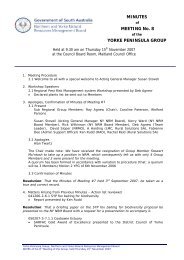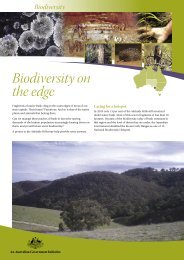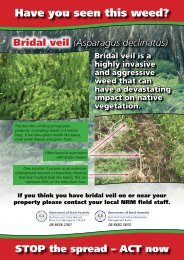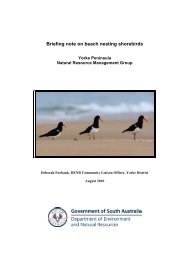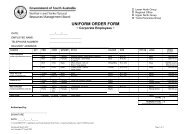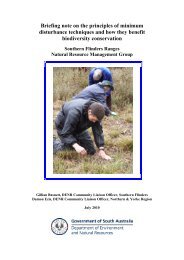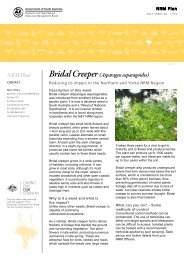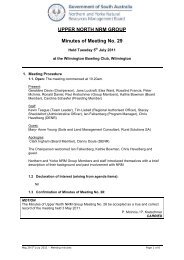Caring for country - Northern and Yorke Natural Resources ...
Caring for country - Northern and Yorke Natural Resources ...
Caring for country - Northern and Yorke Natural Resources ...
Create successful ePaper yourself
Turn your PDF publications into a flip-book with our unique Google optimized e-Paper software.
4feature<br />
Jackie O’Reilly at home in Wirrabara’s ‘sweet spot’. Photo: Clive Palmer Photography, Jamestown<br />
Organic agriculture<br />
Biodynamics is an enhancement of what is<br />
generally termed ‘organic agriculture’. It is<br />
based on the work of the Austrian scientist <strong>and</strong><br />
philosopher Dr. Rudolph Steiner, <strong>and</strong> adapted <strong>for</strong><br />
Australian conditions by Mr. Alex Podolinsky.<br />
It involves improving soil structure <strong>and</strong> fertility by<br />
increasing the microbal activity of the soil with<br />
biodynamic preparations, which are produced,<br />
stirred <strong>and</strong> applied under exacting conditions to<br />
ensure maximum effectiveness.<br />
Soil fertility is maintained by the application of<br />
basalt rock dust <strong>and</strong> rock phosphate, spreading<br />
cow manure, growing legumes <strong>and</strong> returning<br />
all plant material to the soil by slashing <strong>and</strong><br />
brushcutting the orchards.<br />
The aim is to maintain <strong>and</strong> improve soil structure<br />
<strong>and</strong> vitality. No chemical fertilisers, insecticides or<br />
herbicides are used.<br />
According to the government’s SA Food Centre the<br />
SA agrifood industry contributes $12.4 billion to<br />
the state’s economy each year – <strong>and</strong> accounts <strong>for</strong><br />
146,000 South Australian jobs.<br />
Official statistics <strong>for</strong> organic <strong>and</strong>/or biodynamic fruit<br />
<strong>and</strong> vegetable produce are hard to come by but<br />
organic wholesalers estimate the local market at<br />
about $10 million.<br />
Sam Aloisi, a wholesale dealer with Steve’s Organics<br />
at the Pooraka produce market, reckons the market<br />
<strong>for</strong> organic produce in SA has grown by about 30<br />
per cent over the past five years.<br />
“The eastern seaboard is where the real action is <strong>and</strong><br />
the bigger local growers send produce to Sydney<br />
because that’s the market where consumers are<br />
willing to pay big premiums <strong>for</strong> certified organic<br />
produce,” Mr Aloisi said.<br />
He estimated there were about 20 South<br />
Australian organic growers with enough volume<br />
to supply the local wholesale market on a<br />
regular basis.<br />
“But there are always new organic shops <strong>and</strong><br />
growers popping up all over the place but as <strong>for</strong><br />
making serious inroads into the heavy duty retail<br />
food business, they are unlikely to compete<br />
with suppliers with the firepower that big<br />
retailers dem<strong>and</strong> - huge steady stocks of<br />
uni<strong>for</strong>m product.<br />
“But SA’s organic suppliers have some excellent<br />
niche markets – such as the increasingly popular<br />
growers’ markets – or direct retail - where they<br />
can charge a decent premium <strong>for</strong> organically<br />
grown produce.”<br />
<strong>Northern</strong> <strong>and</strong> <strong>Yorke</strong> <strong>Natural</strong> Resource Management Board 13




